Nearly 40 vintages of Château Pichon Longueville Baron
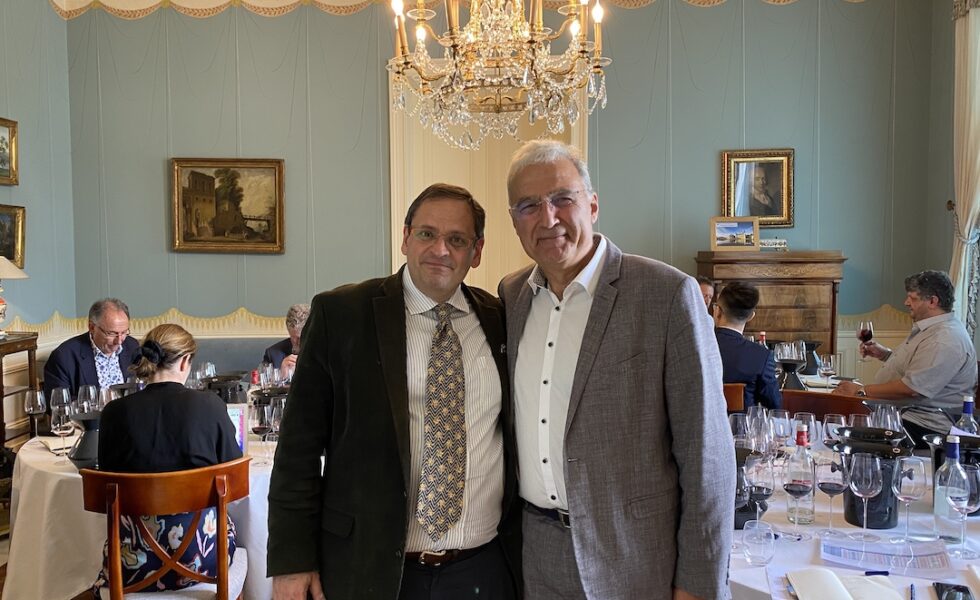
In honor of Jean-René Matignon
By Panos Kakaviatos for wine-chronicles.com
14 October 2022
I recall the disappointment in Jean-René Matignon’s face as rain started falling towards the end of the 2006 harvest. “This could have been as good as 2005,” he said regretfully. Some 16 years later, tasting the 2006 at Château Pichon Longueville Baron in a vertical of 37 vintages, the wine tasted as one might have expected: not as good as the 2005, but pretty good, proving the point that excellent terroir from an estate like Château Pichon Longueville Baron can shine over time, even in a less than “great” vintage.
On May 24th this year, the estate invited me to join a special Au Revoir tasting and lunch featuring vintages spanning Jean-René’s career with the château. We also enjoyed magnums of 1959 and 1961 over lunch (of course pre-dating Jean-René’s arrival at Pichon Baron).
Despite some off bottles, the global high quality experienced testifies not only to the excellence of the terroir, but also to the talent of Jean-René and his team.
On two occasions earlier this century, Jean-René joined me for “winemaker dinners” that I had organized in German cities and in Washington D.C., where participants appreciated his affability and informative feedback when they posed questions. In my experience as a journalist and wine events organizer, I came to admire Jean-René as both a professional and kind man, who exudes passion and love for wine.
Over his tenure, he and his team blazed a trail to make powerful Pauillac wine with refinement, increasing the amount of Cabernet Sauvignon in the blends, reducing the percentage of the grand vin while increasing the new oak. Of 72 hectares owned by the estate today, the first wine is made primarily from older vines growing on a prized 40-hectare plateau of gravel beds with poor soils that force vines to go deep into the ground. But that was not the case in the 1990s.
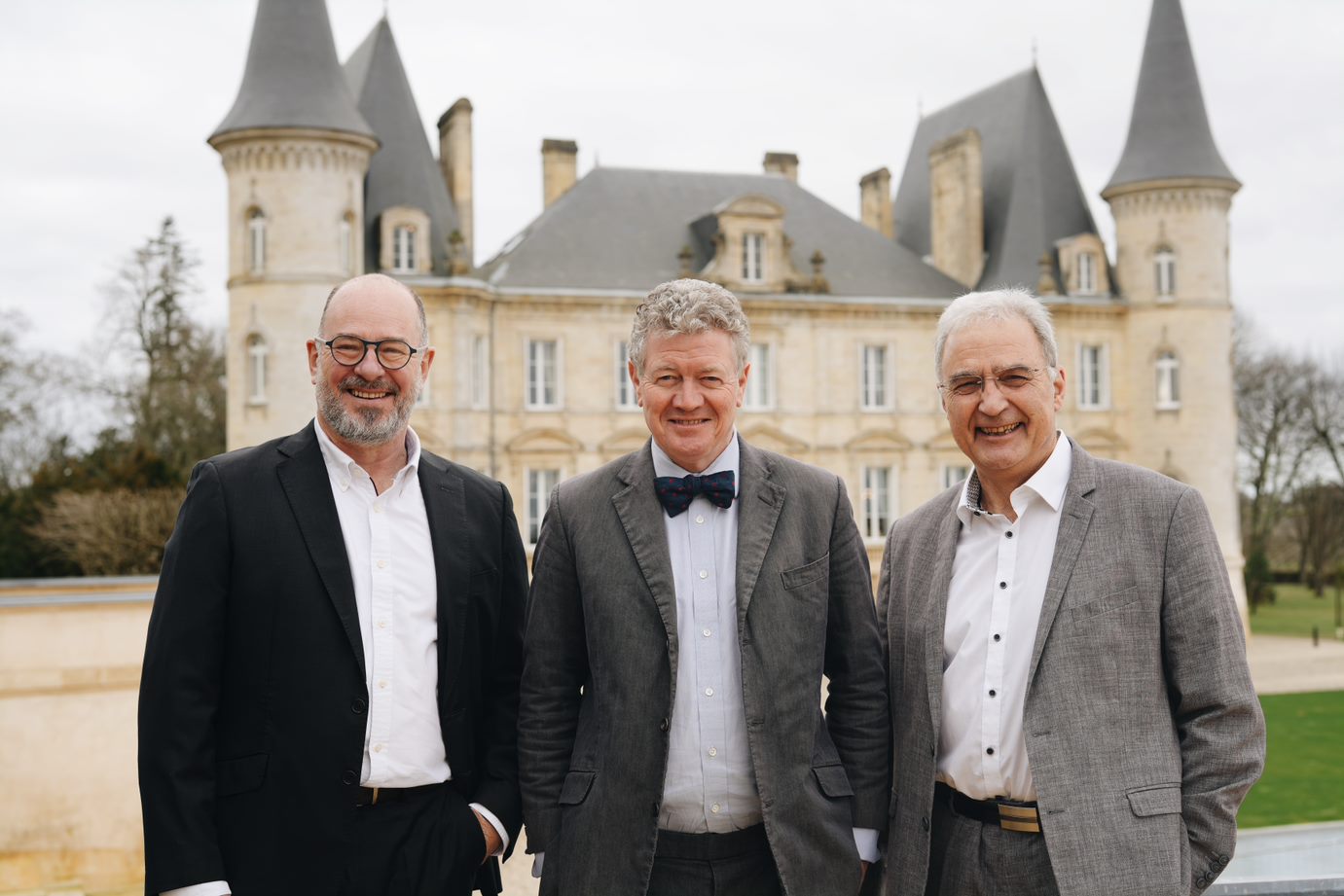
Left to right at the estate: Pierre Montégut, who has taken over from Matignon, Christian Seely and Jean-René / ©Château Pichon Baron
“When I arrived, we [along with Jean-René] reached a strategic decision to make considerably less Pichon Baron than before,” explained Christian Seely, managing director at AXA Millésimes, which owns the estate.
Grapes from Merlot vines west of the plateau that had previously been used to make the grand vin in the 1990s now make more of the second wine Les Tourelles de Longueville, a blend with 65% Merlot that ages in 30% new oak – and is meant for earlier consumption. Since 2012, even less grapes were used to craft Pichon Baron, with the introduction of Les Griffons de Pichon Baron, a second second wine with more Cabernet in the blend, crafted from parcels “geographically and in personality closer to the character of Pichon Baron,” Seely explained.
The resulting increase of Cabernet Sauvignon in the blend of the grand vin – from about 60 percent Cabernet Sauvignon and 40 percent Merlot in the 1990s, to an average 80-20 blend today – lends a more foreboding aspect to this venerable Second Growth, especially when compared to neighbor Pichon Longueville Comtesse de Lalande, for example. In addition, the wine is aged in 80 percent new oak, as compared to 50 percent for Pichon Comtesse, accentuating a “larger-scaled” aspect (I like to compare the two superb properties, as they once were united).
It was a pleasure to have taken part in such a wonderful comprehensive tasting in impeccable conditions, with many thanks to the estate. And to have learned that Jean René will be succeeded by Pierre Montégut, the talented technical director at AXA Millésimes’ Château Suduiraut, where he has been crafting both dry and late harvest wines over the past 16 years.
Over lunch both older vintages showed well. Seely recalled having tasted the “beautiful” 1959, essentially made from vines of the 40-hectare plateau. While the intention is not to “copy” that older wine, it is to make wines that best reflect the “soul of the place”, Seely explained.

Happy lunch with two magnums / Photo by Jean-Marc Quarin
When we got to the 2005 vintage for the vertical, it marked a “turning point” for quality and quantity. “It showed how great the wine can be, and it ensured that I would keep my job given the high-risk strategy of making half as much wine as we had before,” Seely stressed.
But over lunch, this bottle of 1961 outgunned the excellent 1959, with impeccable pristine refinement and power: a tour de force and one of the best older Bordeaux I have had in over 20 years tasting Bordeaux wines. In short, I give the 1961 magnum 100 points and the 1959 97 points.
Tasting notes of wines spanning the career of Jean-René Matignon
As usual, when in bold, I liked in particular. If red and bold, even more. Underlined, too? Nirvana wine!
1985 – What lovely elegance! Tobacco leaf, Havana cigar with truffle. This wine – cropped at over 60 hectolitres per hectare – seduced with vivid notions of baked plum and spice. I could see why some preferred the 1986, and how it (might) turn out better later. For now, 1985 gets the nod. 96/100 (Drink to 2035/40)
1986 – Superior grip and power, but it lacks the 1985 charm. Improves with time in glass: cool blueberry fruit and superior density coming to the fore. The 75% Cabernet Sauvignon and 25% Merlot with 12.5° alcohol evoke cedar and blackberry liqueur. But the tannin remains a bit unresolved: a “long-term” keeper. The cold and snowy winter that year was followed by a late, wet spring. With excellent weather in summer and autumn – little rain and generous sunshine – the Cabernet Sauvignon achieved excellent maturity in late October. 95/100 (Drink to 2045)
1987 – Hardly a star vintage, but Pichon Baron does not disappoint. I enjoyed the saddle leather with barely discernible brettanomyces. With less palate density compared to the two preceding vintages, and a finish marked by rusticity, this 1987 is however smoother than expected with coco powder sweetness and an easy drinking feel, some 35 years later. Tasty wine. 90/100 (Drink up)
1988 – Tobacco leaf, cassis and roasted fruit emanate from this blend of 70% Cabernet Sauvignon and 30% Merlot. Aged 12 months (aging now is about 20 months with more new oak) in 60% new oak barrels and 40% one-year-old barrels. The high-toned palate has more acidity than the three preceding wines, yet the brisk nature is balanced by fine density (lacking in the 1987). While neither as powerful as the 1986, nor as charming as the 1985, I like the grip. Cropped at 60 hectolitres per hectare. 93/100 (Drink to 2035/40)
1989* – Wow comes to mind. In an era when the harvest was cropped at up to 60 hectoliters per hectare, the results from this blend of 73% Cabernet Sauvignon and 27% Merlot having aged in 65% new oak for 15 months could hardly be better! Even with lower yields of today and better selection… One of the best wines ever tasted here, the 1989 is powerful and refined – and it excites with opulence and verve, conveying vivid cedar, tobacco, blackberry, spice, and creosote. Very complex aromatics and a palate oh so complete, so spherical, without gloss or polish. Very long finish. Amazing. Only topped by the lunchtime 1961. 99/100 (Drink to 2050+)
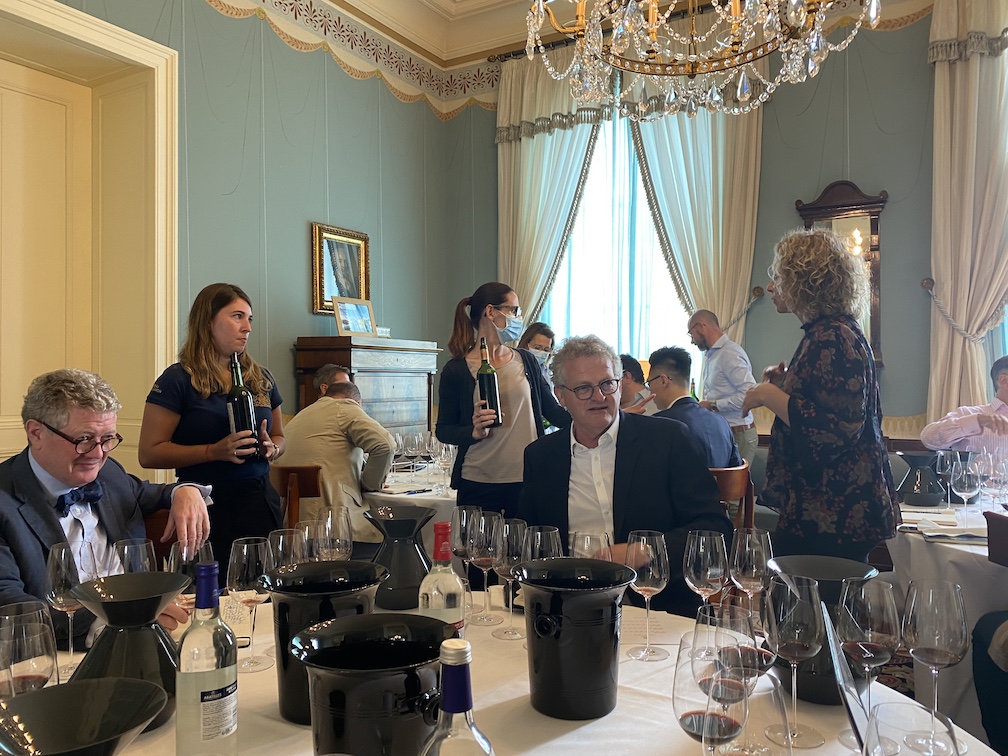
Christian Seely at left with Gavin Quinney of Château Bauduc, seated with me at the tasting.
1990 – Tasters were somewhat divided comparing this with the 1989… I found this bottle of the 1990 to be leafier and earthier; its tone indicates faster evolution. But I liked the smooth, even creamy palate, with custard like sweetness even if thoroughly dry and thoroughly Pauillac in its tobacco expressions with depth and power. A slight note of burgeoning rusticity however puts it in the back seat compared to 1989. Cropped at close to 70 hectoliters per hectare, the harvested grapes were rather large: Merlots picked by 27 September and Cabernets by 16 October, under clear, sunny skies. Like the 1989, 73% Cabernet Sauvignon and 27% Merlot, but with 70% new oak aging for 15 months. 97/100 (Drink to 2045)
1991 – As with the 1987, a lesser vintage, but very good. 1991 is known for devastating frost that struck vineyards in April, destroying young buds. Although summer was good, heavy rains drenched vineyards in September, compromising the vintage. Estates closest to the tempering Gironde did better with the very small crop. While the 1991 lacks the depth and power of the two preceding star vintages, Pichon Baron is smooth with medium body. A rustic finish detracts. 90/100 (Drink up)
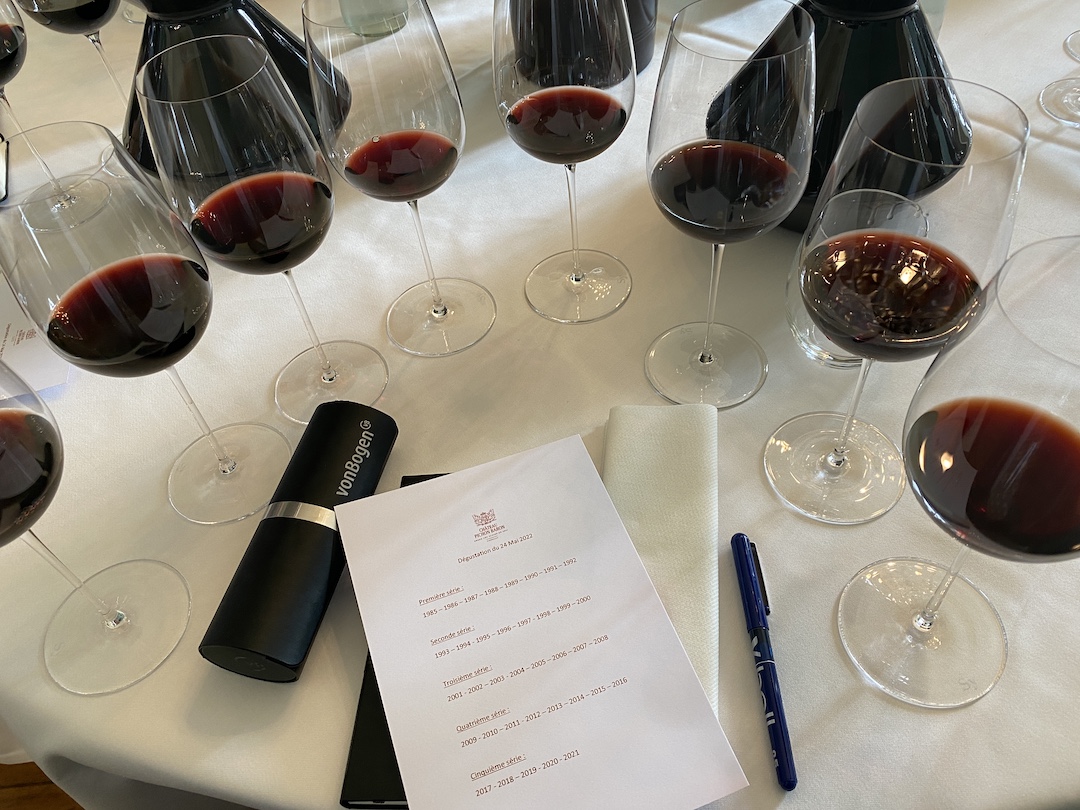
My perspective
1992 – An agreeable wine, but somewhat dilute. While 1991 was struck by low yields because of the frost, 1992 is known for being thin, with the most summer rainfall over 50 years up to that year. Green harvesting proved a useful tool to counter excessive growth, and Pichon Baron did that. However, continued rain over the October harvest time ended up making the vintage less memorable. So far, the weakest showing. 87/100 (Drink up)
1993 – Not much charm, as if a wall of tannin. I wonder if this was an off bottle, as 1993s tend to be more charming albeit dilute. Note reserved.
1994 – The best vintage since 1990. It exudes freshness and refinement, breed, and terroir. While it lacks the wow factor of 1989 and 1990, tannic power and meaty succulence beckon food. Savvy buyers should scoop up the rather inexpensive 1994s as the wine is drinking well some 27 years later. 93/100 (Drink to 2035)
1995 – Served from magnum, this deeply colored blend of 65% Cabernet Sauvignon and 35% Merlot (a vintage known for Merlot) proved somewhat disappointing. The grip and power are undeniable, but I could not shake a sense of odd under-ripeness. It could have been the bottle, so note reserved.

You would think that 10 bottles in a vertical would be great, but we went through nearly four times as many!
1996 – Pichon Baron lives up to this star vintage from the Left Bank. The Cabernets excelled, taking advantage of longer hang time for ripening, which explains 80% Cabernet Sauvignon (20% Merlot). Dense and radiant, the freshness of the bouquet (tealeaf, forest floor, tar, and bright red cherry) impresses. Profound and precise, the palate delivers smoothly textured tannin leading to a long, Havana cigar like finish. While not as inspiring as the 1989, the 1996 is just terrific. Aged in 70% new oak. 96/100 (Drink to 2045)
1997 – From magnum and one of the most surprisingly yummy wines: suave, cooler blue fruit, powdered chocolate, cherry and plum. Sure, the 1997s were generally overpriced upon release (en primeur in general) and considered inferior to 1996 and 1995, but the laser precision and linear finish are marked by pure fruit. It lacks the depth and power of the 1996 or especially the 1989, but the 1997? Just beautiful to enjoy now – and for some years to come. 95/100 (Drink to 2035+)
1998 – I recall trying this blend of 80% Cabernet Sauvignon and 20% Merlot (having aged 15 months in 70% new oak) back in 2005, and it was shut down. While its nose is still somewhat steely (served from magnum, slower evolution), the wine shows elegance this year, with noticeable density and power. While the latter traits are better than the 1997, I prefer the 1997 and its charm for current drinking. I am not sure if the 1998 will ever convey such charm. The thing about 1998 is that it was more a Merlot year, and I wonder about the maturity of the Cabernets, which was not a problem in, say, 1996. 92+/100 (Drink to 2030)
1999 – A wine of charm, recalling the 1997 style, with bright, red fruit (cherry and raspberry) and Pauillac power – perhaps more than the 1997, although a relatively short finish lets me down as compared to the 1997. But no matter: this vintage is drinking well today, and I would recommend it especially if the price is right. 93/100 (Drink to 2030)
2000 – A top wine that fulfils the mythical promise some critics expressed on release, foremost Robert Parker. Juicy, powerful, and balanced, reflecting ripe black and red fruit purely expressed, this blend of 70% Cabernet Sauvignon, 25% Merlot and 5% Cabernet Franc was aged in 80% new oak that is so well integrated. While fresh and open knit, the wine also is dense and powerful. I admire the refined tannin and Burgundian wet stone. Glorious! Will gain in complexity. 98/100 (Drink to 2060)
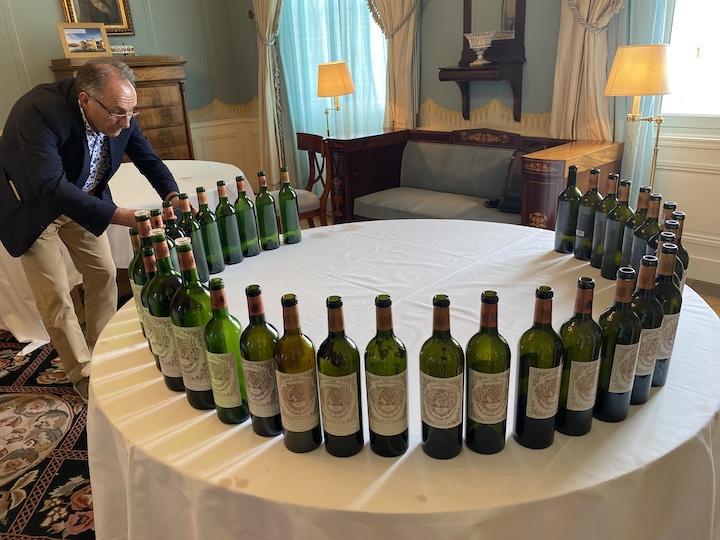
A popular photo of all 37 vintages tasted, with wine writer Jean-Marc Quarin taking a snap
2001 – Overshadowed by the 2000 vintage, the 2001 shows quality in a similar blend of 70% Cabernet-Sauvignon, 27% Merlot and 3% Cabernet Franc, having aged in 70% new oak for 15 months. I like its verve and power, even if not as “majestic” as the 2000. Indeed, there is tightness to the palate, but I am confident that it will gain in complexity and interest, although it will never match its older sibling, contrary to what some contrarians might say. 94/100 (Drink to 2040/45)
2002 – For several years, the 2002 put on a good show, especially compared to the 2001. I purchased some bottles, and enjoyed the vintage in 2012, for example. But the 2001 is clearly superior now. That awful, rainy August of 2002 preceded a very good Indian Summer that ripened the Cabernet Sauvignon, which makes up 65% of the blend (35% Merlot), having aged for 15 months in 70% new oak. For a while the 2002 did show promise, but unlike what some critics said at the time, 2002 is no 1996. Despite pleasing tobacco and cedar aspects today, the wine conveys harder tannin and a leaner mid-palate that dries a bit on the finish. 88/100 (Drink up)
2003 – Ah, the vintage of the infamous heat wave: the polar opposite of 2002. And while many 2003s do have overripe flavors (sometimes under-ripe, because the heat resulted in stress), many top estates (like Pichon Baron) from the cooler northern Médoc excelled. Nearly 20 years later, this blend of 65% Cabernet and 35% Merlot, having aged 15 months in 70% new oak (same blend and aging as in 2002) exudes ripe fruit purity, smooth tannin, and good acidity. The terroir (and hard teamwork) paved a path to success. While not as nuanced and fascinating as the 2000 vintage, an excellent showing. 95/100 (Drink to 2050)
2004 – Generally, I prefer 2004 to the 2003 in Bordeaux, as being more balanced, fresher and with less “heat wave” character. Indeed, the finicky Cabernet Franc, which could not handle either 2002 or 2003 extremes came back in the blend in 2004: 65% Cabernet Sauvignon, 30% Merlot and 5% Cabernet Franc, having aged in 80% new oak for 15 months. The wine is pleasant, smooth, tannic, and dense. Although the 2003 has more panache, the 2004 reminds me of a lesser version of the glorious 2000. As such, it gets 94/100, but close to 95. Give it time: All the elements are there for possibly a higher score. (Drink to 2050)
2005 – A great vintage, but too young, hard in 2022 to coax aromas. And yet, dark chocolate from the Merlots and tobacco from the Cabernet slowly emerge. The palate shows impressive density and power, although some austerity, suggesting a closed phase. Do not underestimate the greatness of the vintage, here and in other top Bordeaux properties. Glorious when tasted from barrel, reflecting ripe grapes that, according to Jean-René, showed unprecedented sugar concentration and a “very high polyphenol standard”, noticeable in both the color and the tannins. I suspect that the 2005s have 1986 style structure requiring more time to blossom. A conservative score for now. 96/100 (Drink to 2070)
2006 – After the first bottle had a cork issue, the second bottle shined nicely, albeit with tighter tannins than the 2005 and not as fine grained. A blend of 70% Cabernet Sauvignon, 28% Merlot and 2% Cabernet franc, having aged in 80% new oak, the wine has density and power, with a long and subtle finish. 94/100 (Drink to 2050)
2007 – Like the 1997, this blend of 74% Cabernet-Sauvignon and 26% Merlot having aged in 80% new oak exudes charm, elegance, and smooth tannin. I like the overall balance and harmony, and while it lacks the density of the 2006, it has more evident charm today. 93/100 (Drink to 2045/50)
2008 – I like this vintage the most since 2005. Although you get some strict tannin initially, time in glass reveals tobacco, dark, ripe fruit, and spice. The 2008 exudes impressive balance, with fine structure for the long haul and mid-palate fleshiness. Jean-René calls says that the 2008 is “in the characteristic style of the estate, one that can be kept for many years but is starting to mellow out now”, and I agree. 95/100 (Drink to 2055/60)
2009 – A modern day 1990. Sensual, with ripe fruit, and gorgeous tannic finesse, this wine is delicious now and has structure to last a long time. Very long finish. Some people think that 2009 is “too ripe”, but they are bonkers. Rich levels of sugar and anthocyanins turned out to be “well above” those that had been estimated in the pre-harvest ripeness analyses, according to the estate, but polyphenols were extracted very rapidly, which proved a sign of “optimal grape ripeness”. A superlative vintage, gorgeously balanced. Blends 70% Cabernet Sauvignon and 30% Merlot. 98/100 (Drink to 2060/65)
2010 – While not now as sexy as the 2009, the 2010 has more acidity, more alcohol, more power, more tannin. All well balanced, the 2010 also has 1986/2005 like structure, but with superior opulence, waiting to explode. A sleeping beauty that may overtake the 2009, but now displaying some austerity. Do not touch for another five years. A blend of 79% Cabernet Sauvignon and 21% Merlot, having aged in 80% new oak. 97/100, but a higher score in 5-10 years. (Drink to 2075).
2011 – A vintage known for linearity and … occasional leanness. In early days, it was rather tannic for most estates and somewhat under-ripe for lesser estates. But Pichon Baron is one of the best for this vintage, over 10 years later showing impressive grip, smooth tannin, and finesse. I love the focused finish. While it lacks the opulence of a 2009, this blend of 82% Cabernet Sauvignon and 18% Merlot, having aged 20 months in 80% new oak, displays superb integration and balance, displaying purity and focus. 95/100 (Drink to 2060)
2012 – The 2012 is often a vintage that comes across more flattering than the 2011, but not as long. In this case, I felt as if it was a bit shut down, with tannins a bit tight. Not sure what to make of this blend of 80% Cabernet Sauvignon and 20% Merlot, which aged 20 months in 70% new oak. I feel like I caught it in a closed phase!
2013 – The copious challenges of the vintage have been well documented, and staff at Pichon worked hard to make a solid wine from dismal conditions. Indeed, the yields were set at only 20 hectoliters per hectare. The palate displays pleasing brambly fruit with touches of cigar box and creosote. A lighter weight than usual for the Baron, but a decent drink that despite the comparatively short finish, proves pleasurable with 70% new oak aging well integrated. 90/100 (Drink to 2035)
2014 – Here we have a wine that shines especially bright after the 2013, resembling the 2011, but fleshier. Coming before the more media focused 2015, the better 2014s were unjustifiably forgotten. Indeed, hot and sunny conditions in the late summer and early autumn provided good ripening conditions for the harvest, which began in late September with old Merlot vines. After picking the Merlot, which makes up 20% of the blend, the estate paused until mid-October to give the Cabernet Sauvignon grapes enough time to achieve excellent ripeness. Even after the strict selection of grapes in the vineyard, the rigorous sorting has led to a delicious wine combining cool blue and ripe black fruit. Although lacking the density of the 2015 and the sheer breed of the 2016, the 2014 is an excellent wine that has well integrated the 80% new oak aging. 95/100 (Drink to 2050/55)
2015 – Compared to the 2014, the 2015 has greater depth and fleshiness – a vintage that was aged in 80% new oak for 20 rather than 18 months. While some say that 2015 is not as fresh or as focused as 2014, I find the vintage clearly superior at Pichon Baron. Blending 77% Cabernet Sauvignon and the rest Merlot, it is more solar, with water stress having helped to thicken skins leading to early ripening. Indeed, dry and hot weather continued through to July, while stormy periods in August and September boosted ripening. Thanks to firm, strong skins, phenolic maturity progressed without risk of over-ripening. The harvest took place under optimum weather conditions. While some 2015s from Bordeaux do come across a bit too heady, not here: balance and density and power. Merlots harvested from 18-25 September and Cabernets from 1-9 October. 96/100 (Drink to 2060)
2016 – Tasting this wonderful vintage of both density and 2005-like structure in May 2022 was… too early. And yet, from the start you sense incredible harmony, depth, and density. The vintage was marked by widely varying weather conditions with a cold, wet winter, damp spring, and hot, dry summer. But unlike 2018, 2019 and 2020, 2016 benefitted from a longer, splendid Indian summer helping the grapes, especially the Cabernets, to reach excellent ripeness levels and powerful, yet very fine tannins. The Merlot from the plateau was harvested from 3-5 October, followed by early ripening Cabernet Sauvignon in the deep soils of the main terroirs from 10-18 October. The wine blends 85% Cabernet Sauvignon and 15% Merlot, having aged in 80% new oak. Long finish. 97/100 (Drink to 2065+)
2017 – Composed of 79% Cabernet Sauvignon and 21% Merlot and having aged for 18 months in 80% new oak, this vintage is also somewhat forgotten between the superb 2016 and the sexy 2018. But do not miss out. One of the better 2017s, which can be a bit dilute and boring, the Pichon Baron conveys ripeness of fruit and mid palate density, even if it comes across today a bit steely and too young. The tannins need time to calm down in bottle. Certainly, in a closed phase. 92+/100 (Drink to 2055)
2018 – A memorable vintage coming after the very good 2017, the 2018 has higher alcohol (14.5%), richer ripeness, and rather high pH levels. Some dubbed it Californian. It comes down to location and northern Médoc estates like the Baron excelled. Although I prefer the 2016, this is turning out very nicely with luscious, opulent, and deep traits and distinct expressions of jammy, ripe fruit and classy pencil lead. The old Merlot grapes were picked in late September, followed by Cabernets in early October. The final blend of 78% Cabernet Sauvignon and 22% Merlot had been aged in 80% new oak. 96/100 (Drink to 2060+)
2019 – Not as sexy as the 2018, this seems now somewhat strict and in a closed phase, but time in glass yields pure red and black fruit and tobacco leaf, wet stone and perfumed floral hints, especially on the long, precise finish. Similar picking dates for the Merlots and the Cabs as in 2018, and again low acidity, and yet a better “notion” of freshness in 2019. Could it be the higher percentage of Cabernet Sauvignon at 87% and just 13% Merlot? Or slightly cooler nights compared to 2018? Whatever the reason, the grapes became particularly rich in mid-September due to hot, dry conditions. September rains weakened the skins to accelerate the harvest. Jean-René said that this rain was “very welcome” as it “stabilized the sugar concentration and allowed us to continue the harvest more serenely.” 96/100, but potential for a higher score. (Drink to 2065)
2020 – This vintage may beat 2018 and rival the 2019 as it comes across as a synthesis of the two with noticeable freshness. As with the two preceding vintages, ripening took place in hot weather, but then came the second half of August, with thunderstorms of varying intensity: between 80 and 120 mm of rain, hitting Pauillac between 12-16 August. The rains counteracted water stress observed in early August. It is interesting to note that the Merlots especially benefited from the rainfall, with the grapes growing swiftly, unlike the Cabernets, so we end up with a blend with more Merlots than either in 2018 or 2019: 76% Cabernet and 24% Merlot. The harvest took place earlier than the two preceding vintages, from 14-22 September for the Merlot and from 22-30 September for the Cabernet-Sauvignon. It completes indeed a splendid triumvirate! Aging in 70% new oak rather than 80%. 96/100 (Drink to 2065)
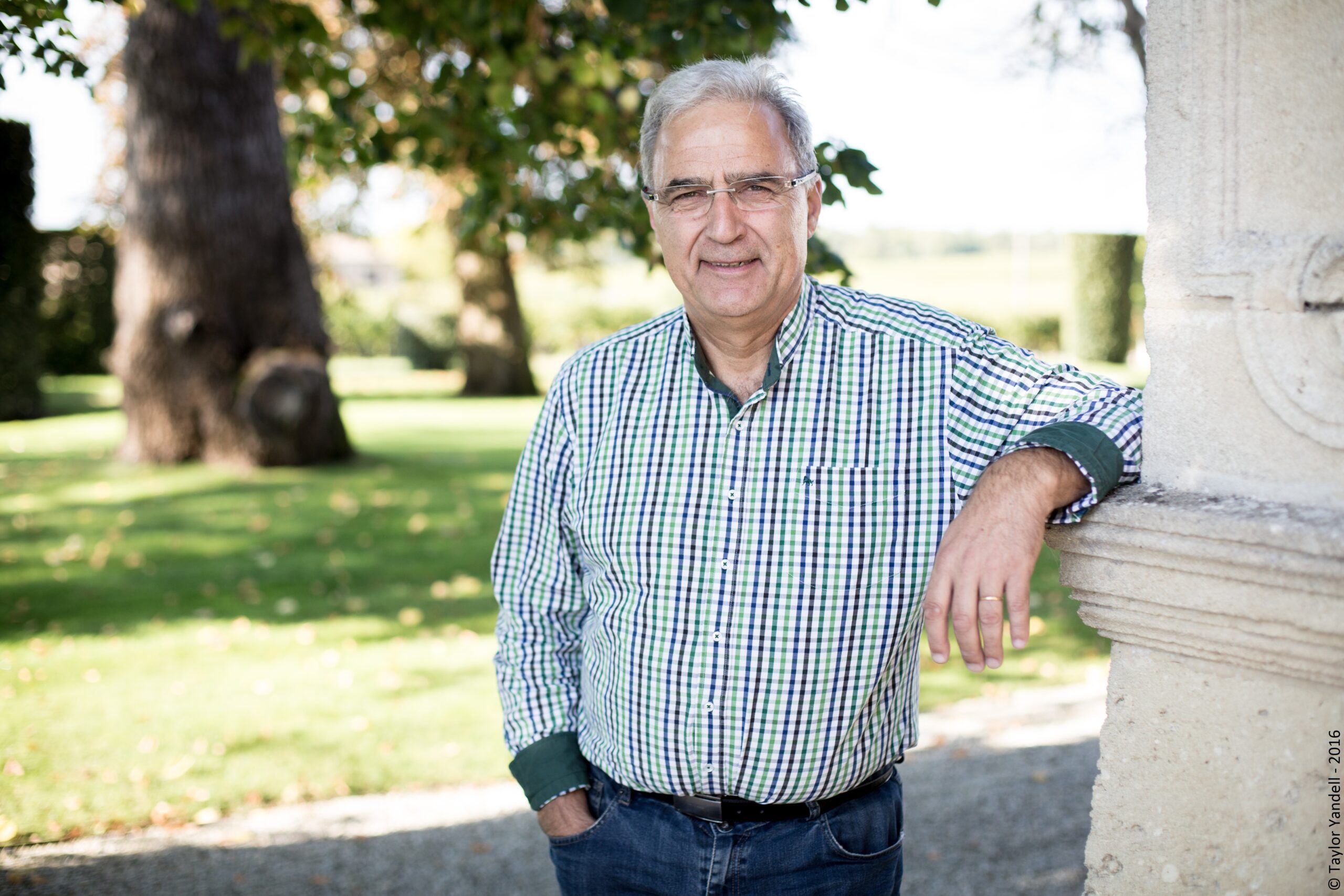
A great guy, whom we will miss! Happy retirement. / ©Château Pichon Baron
Category: Blog Tagged: Axa Millésimes, Château Pichon Longueville Baron, Jean-Rene Matignon, Pauillac, Pichon Baron, Second Growth, Super Second
 Wine Chronicles
Wine Chronicles
Share This